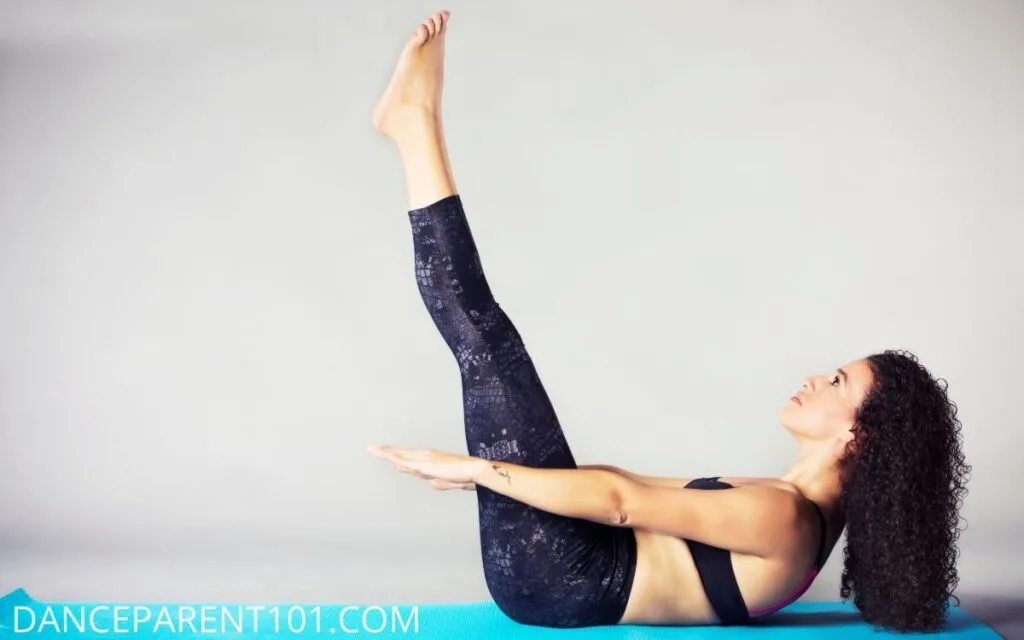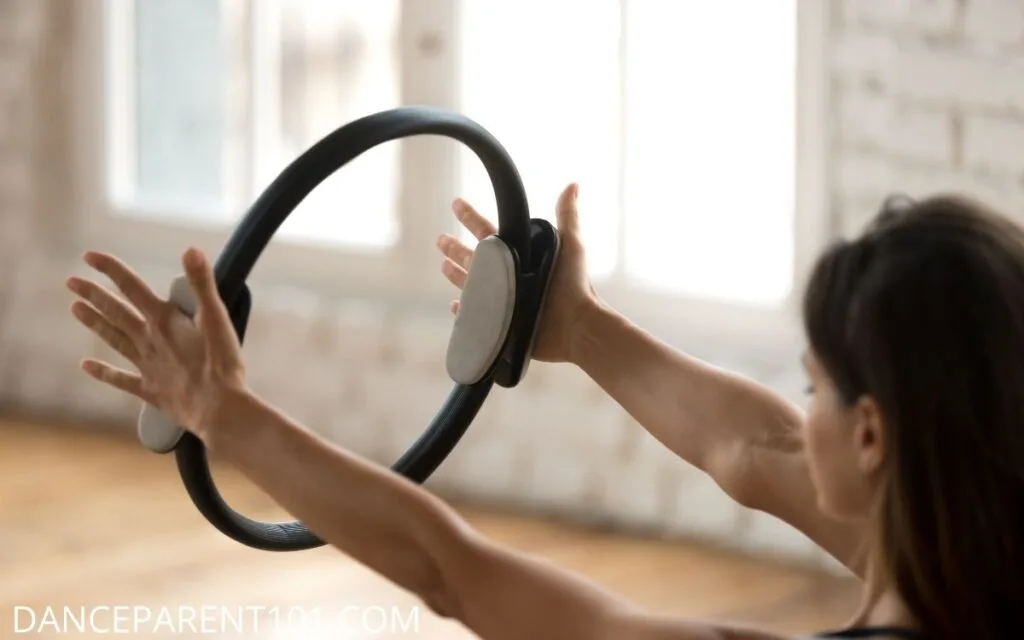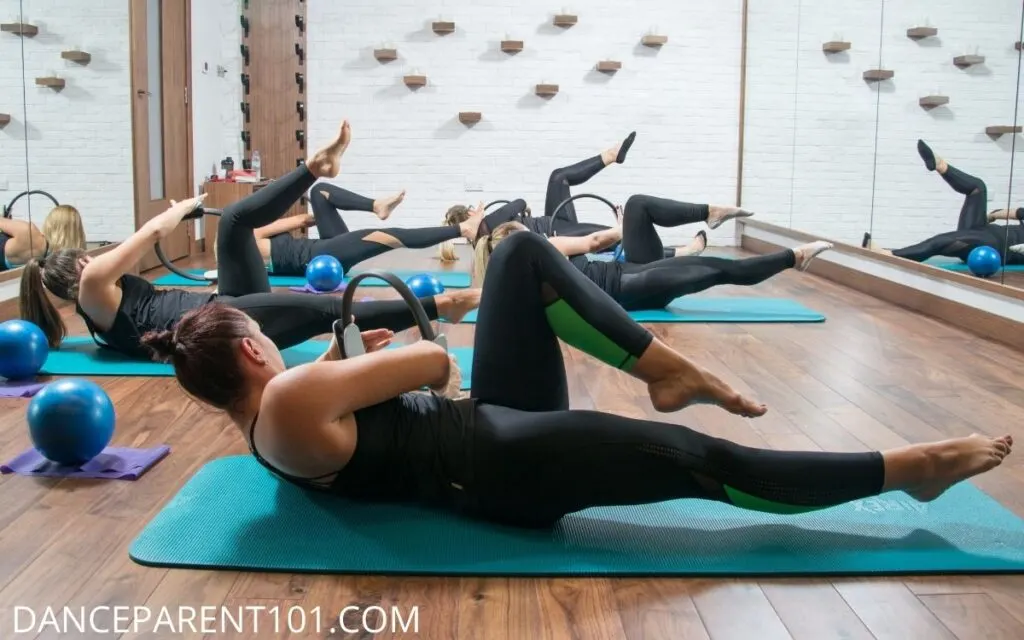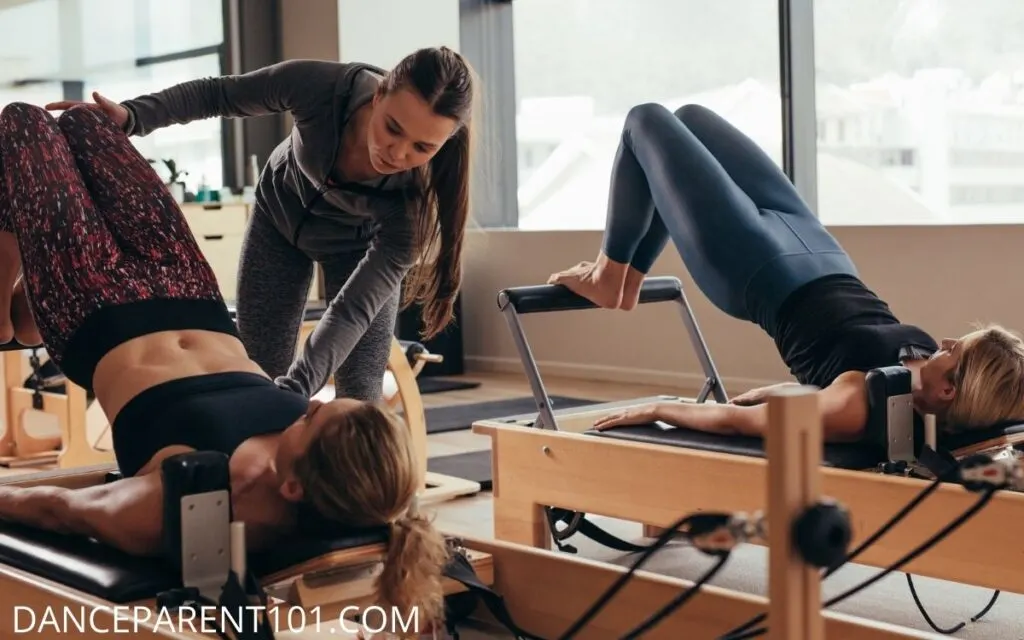By Danielle Pierce-Master, MA Dance / Edited by Samantha Bellerose, B.Ed, Dip.Dance (Performing Arts)
Often playfully confused for “pie and lattes,” Pilates became a household name in the late 1990s as a trendy workout loved by Hollywood celebrities, but it had been an important practice in the ballet world and for modern dancers for decades.
Pilates is a method of body conditioning that focuses on the deep, intrinsic muscles of the core. Pilates is great for dancers because it helps to improve strength, balance, and flexibility. Pilates mat work can be done with no equipment at all, making it a portable workout that can be done anywhere.

I became a Pilates devotee in college, taking classes to support my dance training. I eventually became a certified instructor; I loved teaching my fellow dancers! I definitely found that I could turn more consistently and jump more powerfully when I was doing Pilates regularly.
Pilates is an excellent way for dancers to cross-train and take care of their bodies. Read on to learn more about the method and its benefits!
(Please note that the following article contains affiliate links to items you can purchase from third party sites such as Amazon.com at not extra expense to you.)
What is Pilates?
Pilates’ “System of Contrology” was developed by Joseph Pilates in the early 1900s. Pilates himself was sick as a child and rehabilitated himself through movement. During World War I, he used springs attached to hospital beds to help soldiers rehabilitate their injured bodies. This contraption would eventually evolve into what we now know as the Pilates Cadillac.
The Cadillac, Reformer, Wunda Chair and Barrels are the major pieces of equipment used in practicing Pilates. Unfortunately, equipment training is often in a one-on-one or small group setting and can be costly.
Thankfully, small props like therabands, the foam roller, and the magic circle can help replicate the equipment exercises in a portable and affordable way.
In her Pilates Props Workbook, instructor Ellie Herman identified eight principles of Pilates: Control, Breath, Flow, Precision, Centering, Stability, Range of Motion, and Opposition. Each of these principles are relevant to all of the exercises, but in a given workout focusing on any one of the principles helps to keep the workout fresh.
Why is Pilates Good for Dancers? – The 5 key Benefits!
1. Core Strength, Balance, and Alignment

Pilates exercises focus on the “core” of the body, which refers to the abdominals (which include 4 different muscle groups), the back, the gluteals, and the hamstrings.
These muscle groups are important in all styles of dance; the more the deep muscles work to stabilize the body, the more freedom the limbs have for expressivity.
A strong core also leads to better balance, which is important for ballet dancers who want to do more turns, tap dancers who want to be more stable or more swiftly switch their weight, or breakers who want to balance on their arms!
Mary Carpenter, Master Pointe Shoe Fitter, Ballet Educator and Pilates Instructor, taught beginning ballet at the college level for two decades.
She shared with me that when she was able to incorporate Pilates Mat work before bringing her students to the ballet barre, the students had more accurate alignment, were physically stronger, and progressed more quickly.
She specifically mentioned that her students were able to find their hip rotator muscles and activate turnout in an anatomically correct and safe way.
2. Injury Recovery and Prevention

Seattle-based Pilates and Ballet teacher Suzanne Singla found Pilates when she was recovering from a dance-related back injury.
Even after recovering from her injury, she says, “I can’t imagine not having Pilates in my life. It has supported me while having my children, working as a ballet and creative movement teacher, and most recently, training to run the New York City Marathon.”
Carpenter was also introduced to Pilates through a physical therapist when recovering from an injury early in her dance career, and contends that her Pilates apparatus training prevented her from needing to have knee surgery.
I also have a tale of Pilates helping me through injury; I was doing less of it and dancing more, and ended up with a lot of hip pain that neither doctors nor physical therapists were very helpful with. But I returned to Pilates and was eventually able to dance without pain again.
While Pilates is great for helping dancers rehabilitate after injuries, it is also an excellent tool in the dancer’s toolbox to prevent injuries from happening.
Beyond the increased strength, focused Pilates practice improves dancers’ proprioception, or body awareness, which helps them to be even more precise in their dancing.
Practicing Pilates also builds an understanding of anatomy and how the muscles work together, creating a more refined use of one’s instrument.
3. Cross-Training

Still in the realm of injury prevention, Pilates offers dancers an opportunity to utilize their muscles in ways that are complementary to, yet, different from dancing.
Repetitive motion of any kind can cause muscular imbalances and Pilates helps to even out the body.
Imagine a dancer learning a new ballet, where they do the same step numerous times on the right side, but none on the left.
Rehearsing the piece dozens of times, followed by an extended run of performances can lead to differences in strength on both sides. Pilates offers a dancer the opportunity to re-center and balance out their body.
Additionally, ballet dancers work mostly from a turned-out position.
Constant strengthening in a turned-out position strains and tightens the muscles that do that job while leaving the muscles that work in parallel or turned in unattended and weak.
Pilates addresses the hips’ full range of motion, so the joint can be supported by all of the muscles that surround it.
Most humans do not naturally have the dramatic rotation in the hips that ballet calls for, the external rotation exercises in Pilates also help dancers to maintain strength in whatever turn-out they do have.
4. Mind-Body Connection and Muscular Isolation

Dance is, without a doubt, a mind-body activity (and my personal favorite of them all).
Dance training is also multi-layered. In a single exercise, a dancer is considering where every individual part of their body is, what steps they are doing, how they are connecting to the music, where they are in the space, and what emotive quality they are projecting.
Technical training builds much of the physical to a level of automatic, but just typing this I am in awe of what we as dancers do! Pilates helps a dancer to have their musculature working in an efficient way, in addition to having the opportunity to focus on specific muscle groups one at a time.
5. A Great Side Hustle or Second Career

For dancers who practice Pilates regularly and fall in love with the method, Instructor Certification Programs can lead to a great survival job that can offer flexible scheduling to support a dance career.
It is possible to pursue either just a Matwork or a Comprehensive Certification.
When I was pursuing performing in NYC, it was great that I could teach a Mat Class at a gym or a few private sessions before even starting the day of auditions or dance classes.
Many of my fellow instructors were also dancers, some of whom had completely moved on from performing.
The process of getting certified also deepened my knowledge of the human body, diversified my skill set, and made me a stronger, more informed, more confident dancer.
To Find Out More
If I’ve convinced you that your dancer needs Pilates in their life, my first suggestion would be to seek out a local studio where one on one apparatus instruction is available.
This can be expensive and isn’t necessarily sustainable long-term, but it is a great way to get introduced to the work and develop a good foundation (and also makes a great gift for a birthday or holiday).
Small group equipment classes and mat classes are great ways to keep up a Pilates practice at a lower cost.
There are also some great places to find Pilates online:
Suzanne Singla and Mary Carpenter, both mentioned above
–Mary Carpenter at the American Liberty Ballet
–NVP Studio– Natalia is a former Ballerina who offers an on-demand program. She also posts amazing exercises on her Instagram Page.
–Pilates on Fifth– This is where I did my instructor training and they offer an on-demand subscription for videos, as well as virtual classes over zoom.

